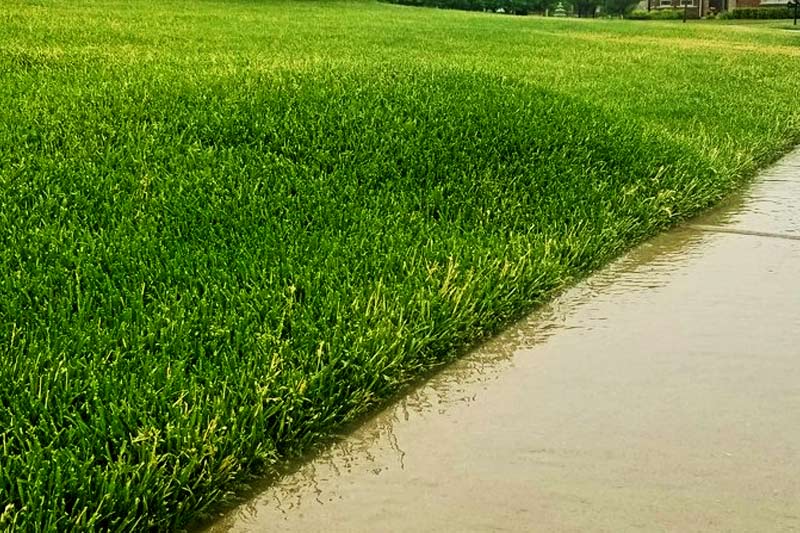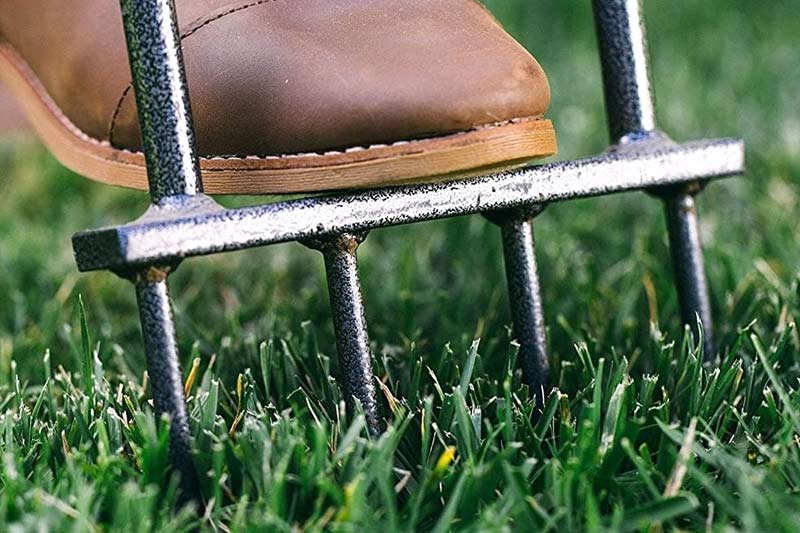Lawn bubbles diminish the aesthetic appeal of lawns and can also negatively impact lawn health. Understanding their causes is essential for effectively eliminating them.
Excess water causes lawn bubbles. They usually form when water gets trapped between your grass and the ground. The increase in pressure that results from this then forces a section of your lawn to bulge upwards, hence the “bubble effect”.
Here is what you need to know.

What we cover
ToggleWhat causes lawn bubbles?
The following are the most common causes of lawn bubbles.
Overgrown or naturally dense root system
Some grass species form really dense and compact root systems. In some cases, lush and thick lawns develop elaborate root systems that help them thrive.
Whichever the case, these root systems can become so dense and compact that they make it hard for the ground to absorb any incoming moisture. The resulting pressure of the collecting water then forces the lawn upwards, and this then results in lawn bubbles.
Extended drought
Prolonged droughts tend to encourage soil compaction. And so when the rains come, or when you over-water your lawn, water will have a hard time seeping through the soil. It is thus more likely to collect under the grass. Eventually, it will cause a bubble.
Plastic layer under your lawn
A plastic layer under your lawn can also be to blame.
And even if you didn’t install it yourself, the previous owners might have installed it:
- to control weed growth
- as part of a soil improvement system — especially if it involves adding topsoil.
If there is any type of plastic in your lawn, it is likely to cause lawn bubbles simply because it will limit the ability of the ground to absorb moisture. This compromised moisture absorbability will then encourage moisture to the pool below your lawn. And it will then result in blistering.
Excess rain
A heavy downpour can cause a grass bubble because it supplies an extreme amount of moisture, instantly. And since the supply is excessive and sudden, it is often more than the rate at which the water drains from your lawn. This then raises your lawn, forming a bubble.
Faulty plumbing
If you have a burst pipe, or if you accidentally overwater your lawn, you can also end up with a lawn blister.
In such a case, since water will be pouring into your lawn at a faster rate than it is being drained off, a significant amount will be trapped under the grass. This will increase the pressure on the grass layer. And it will then cause it to swell into a bubble.
Can lawn bubbles harm your lawn?
Yes, grass bubbles can harm your lawn.
Nutrient cut off
It often suspends the roots of the grass in the blistered patch. This makes it difficult for the roots to reach the ground. And since your grass will need to sink into the soil in order to absorb nutrients, this is something that will lead to malnourishment.
Therefore, if left unchecked, a grass bubble can lead to poor lawn health.
Cost of removal
There is also the fact that you may have to pop the bubble in order to get rid of the bubble.
This is a traumatic technique that involves hacking through your lawn. Your lawn will lose its aesthetic appeal as a result. And this may even necessitate further lawn repairs that will definitely cost time and money.
How do you get rid of lawn bubbles?
You can get rid of a lawn blister in the following ways.
Wait it out
A lawn bubble forms due to water accumulating under your lawn.
If the bubble in your lawn isn’t severe, you can simply wait it out. Doing so will give the ground enough time to absorb the water. And any water that doesn’t seep into the ground will eventually find its way into a drainage hole.
Fix the underlying cause
The waiting technique won’t work if the cause of the bubble is a burst pipe, lawn watering system, or faulty plumbing. This is because any water that successfully gets off your lawn will simply be replaced. And so the water pressure won’t drop, something that will make it pointless to wait.
In such a case, you will have to fix the underlying moisture source. If it is a burst pipe, a poorly installed sprinkler system, or poorly connected pipes, you will have to fix the problem first. And it is only after fixing it that can you let the water drain out of your lawn naturally.
Puncture the blister
A bubble forms when water is trying to find a way out and so it pushes your lawn upwards. Therefore, you can get rid of it by giving it a path off your lawn. And the most effective way of achieving this is by creating a few holes at the top of the bubble. Doing so will lead to the water flowing out through the holes, and this will be enough to get rid of the grass bubble.
Step on it
If it is a sizable blister, or if you simply don’t want to cut into your lawn, you can apply pressure on top by climbing on top of it. Stepping at the center of the bubble will force the water to spread outwards. And this will eventually direct the water off your lawn and into a drainage hole.
For the best results, start applying pressure from the side that is opposite your lawn’s drainage hole. And then move slowly in order to direct as much water as possible toward the hole.
Repair it
After you are done removing the blister, it is now time to restore your lawn’s appearance. The best method to do this is by applying fine soil to cut sections and then seeding the areas.
If your lawn sustains significant damage from the grass bubble, then you may have to cut out the affected sections. Thereafter, replant grass or lay turf mat.

How do you prevent lawn bubbles?
Lawn bubbles can be prevented by:
- Fixing plumbing problems as soon as they pop up. If you can’t fix it yourself, call a plumber immediately.
- Raise the center of the lawn by adding more soil to it. Doing so will discourage the water from pooling at the center. It will instead force it to wash to the sides from where it can easily drain away.
- Install a french drain. The drain will guide any excess water from your lawn. This will ease the pressure that the water is placing on your lawn. And this can go a long way toward reducing the odds of a blister developing.
- Don’t forget to add gravel and sand to the soil. Both are great at improving soil drainage. They will accelerate the rate at which moisture seeps through your lawn, and this will reduce the pressure on your lawn.
- Aerate your lawn at regular intervals. This should be done at least every 3 years.
Use this free service to find an expert near you
If you need help getting rid of, or preventing, lawn bubbles, HomeGardenGuides.com offers a free service that quickly matches you with the top-voted local experts in your area.
You can get 3 estimates fast by real certified experts in your area in just 2 minutes. Here is how it works.
- You scroll to the top of the page and enter your Zip code.
- Answer questions about your bed bug problem
- Your details will be forwarded to three local experts.
- You will then receive a price estimate for the job and some friendly advice.
IMPORTANT: There is no obligation to hire. This is a free tool and service to be used at your pleasure.






